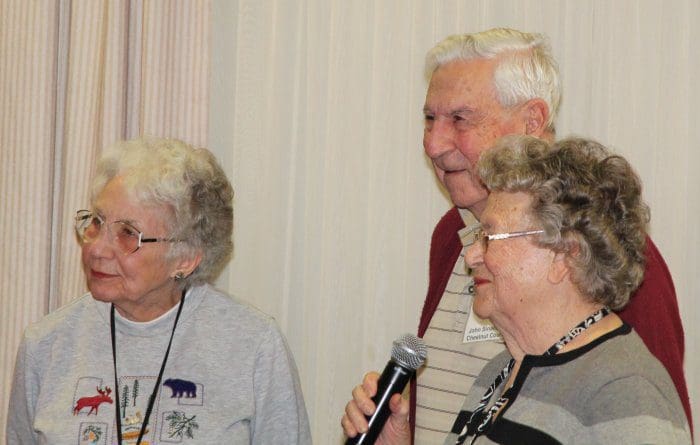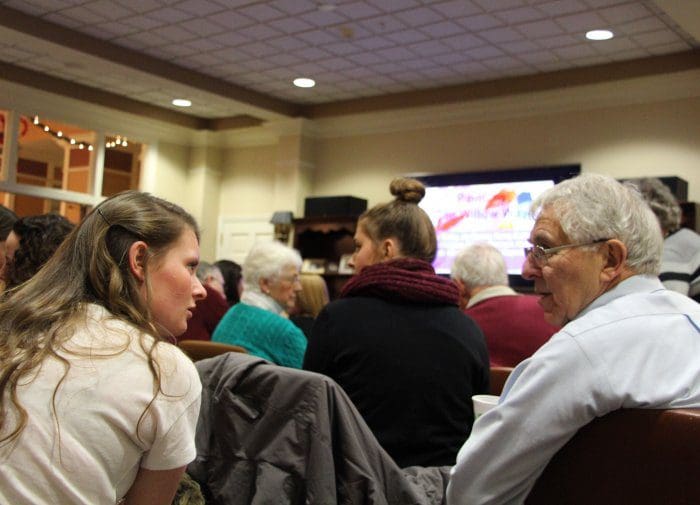Learning Program Partners St. John’s Elders with Nazareth Students
In the beginning of Dr. David Steitz’s career, his aging studies courses looked much different than they do now. “There would be 150 college students sitting in front of me,” explains Dr. Steitz, then a 22-year-old graduate student at Syracuse University. “I’d be talking about what it’s like to grow old, because that’s what the text book said growing old was like. It was lame.”
Today, Dr. Steitz is now an Associate Professor of Psychology at Nazareth College, and heads the school’s Gerontology Program. Those early attempts at teaching about growing older helped him envision a much more authentic and meaningful learning experience for his students. St. John’s Collaborative for Intergenerational Learning, a truly unique educational program for both Nazareth students and residents from St. John’s, is the product of that vision. At the start of each fall and spring semester since the Collaborative began in 2009, a group of residents from St. John’s Meadows and Brickstone by St. John’s have joined a full class of Nazareth students to help them understand what the aging process is really like. Dr. Steitz insists that St. John’s residents who join the class are not just there to provide an occasional talking point or anecdote—they actively participate in shaping the direction of the course. “They help create what we do throughout the semester.”

As a former educator, St. John’s Meadows resident John Sinacore agrees with what he calls Dr. Steitz’s “student-centered learning approach.” Sinacore, who worked as a Professor and Chairperson of the State University of New York’s Health Science Department, always encouraged professors to get their students out of the classrooms and lecture halls for more experiential learning opportunities. “Once you get students involved in exploring, they start to find the answers themselves,” he said. John and his wife Angie have taken part in the St. John’s Collaborative each semester since moving back to the area in 2014. “These are the types of programs that attracted us to St. John’s and enticed us to move here,” explains Angie.
On Tuesday nights this fall 18 St. John’s elders joined 25 students from Nazareth in the St. John’s Briarwood Multipurpose Room for PSY 355- Aging & Community Service. Throughout the semester, students from 19 to 93-years-old worked together on community impact projects, with the goal of identifying some sort of segregation within the community and building solutions to bring people of all ages and backgrounds closer together. “They find some group that is not feeling as though they are part of the larger Rochester community and they develop a solution that creates dialogue and works to develop a sustainable program to combat it,” said Dr. Steitz.

The final class meeting of the semester featured presentations that described the experiences each of the student groups had developing their plans together and working with participants from area non-profit organizations, including Willow Domestic Violence Center, Sojourner House at Pathstone, and Life Prep at Naz. The Sinacores were involved in a project that served a group of children from the Hillside Family of Agencies. Students from the Collaborative visited the children on a Saturday and knitted blankets together. When undergraduate and elder students, as well as children and staff from Hillside, all looked back on the experience, it became clear that the new blankets were not the only results of this project. New, meaningful relationships were formed. “This was a wonderful experience for all,” said Maria, a teacher from Hillside, “for both young and old. I mean elder.”
The impact on the elders who participate is indeed a powerful one. Angie said that the “Nazareth Five” they worked with all semester have now become their unofficial grandchildren. They also hope to stay in contact with the Hillside children. For the Nazareth students, many of whom who are studying to become physical, occupational, and speech therapists, the program provides a chance to get to know a population they will likely interact with throughout their careers. Past students have even commented that participation in the Collaborative has helped better position them to land their first job out of college. With results like that, it is hard to argue with Angie when she calls the Collaborative a “win-win” for all involved.
The Fall 2016 semester of the collaborative featured PSY 354- Issues in Aging. Final presentations included topics on End-of-life care, the Future of Medicare, Ageism, and Physician-Assisted Death.
